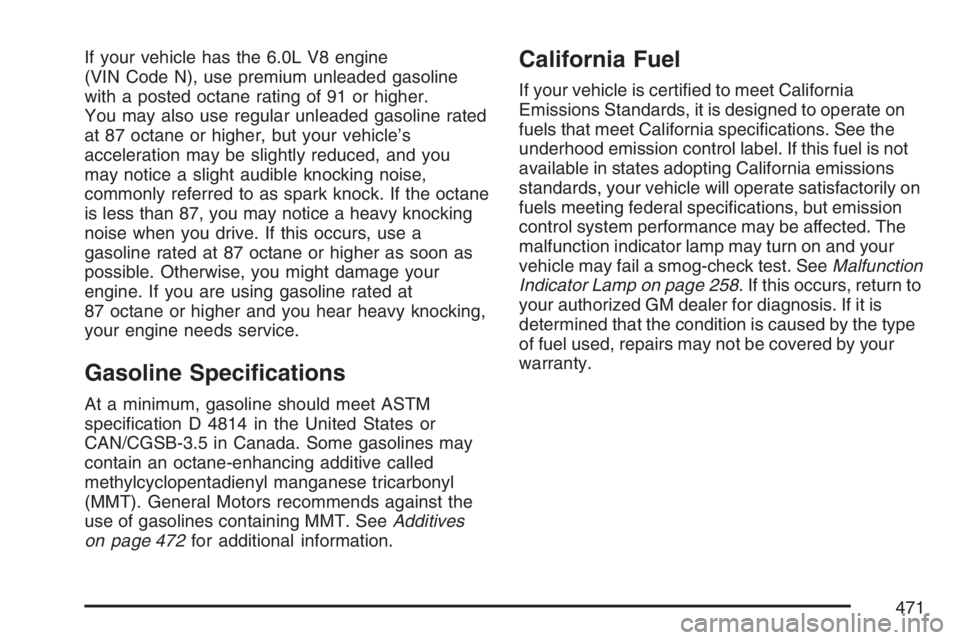Page 471 of 674

If your vehicle has the 6.0L V8 engine
(VIN Code N), use premium unleaded gasoline
with a posted octane rating of 91 or higher.
You may also use regular unleaded gasoline rated
at 87 octane or higher, but your vehicle’s
acceleration may be slightly reduced, and you
may notice a slight audible knocking noise,
commonly referred to as spark knock. If the octane
is less than 87, you may notice a heavy knocking
noise when you drive. If this occurs, use a
gasoline rated at 87 octane or higher as soon as
possible. Otherwise, you might damage your
engine. If you are using gasoline rated at
87 octane or higher and you hear heavy knocking,
your engine needs service.
Gasoline Speci�cations
At a minimum, gasoline should meet ASTM
speci�cation D 4814 in the United States or
CAN/CGSB-3.5 in Canada. Some gasolines may
contain an octane-enhancing additive called
methylcyclopentadienyl manganese tricarbonyl
(MMT). General Motors recommends against the
use of gasolines containing MMT. SeeAdditives
on page 472for additional information.
California Fuel
If your vehicle is certi�ed to meet California
Emissions Standards, it is designed to operate on
fuels that meet California speci�cations. See the
underhood emission control label. If this fuel is not
available in states adopting California emissions
standards, your vehicle will operate satisfactorily on
fuels meeting federal speci�cations, but emission
control system performance may be affected. The
malfunction indicator lamp may turn on and your
vehicle may fail a smog-check test. SeeMalfunction
Indicator Lamp on page 258. If this occurs, return to
your authorized GM dealer for diagnosis. If it is
determined that the condition is caused by the type
of fuel used, repairs may not be covered by your
warranty.
471
Page 532 of 674
Fan and Drive:
Removal of fan clutch, if the vehicle has one,
or rendering clutch inoperative.
Removal of the fan shroud, if the vehicle
has one.
Air Intake:
Removal of the air cleaner silencer.
Modi�cation of the air cleaner.
Exhaust:
Removal of the muffler and/or resonator.
Removal of the exhaust pipes and exhaust
pipe clamps.
Bulb Replacement
For the proper type of replacement bulbs, see
Replacement Bulbs on page 541.
For any bulb changing procedure not listed in this
section, contact your dealer.
Halogen Bulbs
{CAUTION:
Halogen bulbs have pressurized gas
inside and can burst if you drop or
scratch the bulb. You or others could be
injured. Be sure to read and follow the
instructions on the bulb package.
532
Page 542 of 674
Windshield Wiper Blade
Replacement
Windshield wiper blades should be inspected for
wear and cracking. SeeScheduled Maintenance
(Gasoline Engine) on page 617for more
information.
Replacement blades come in different types and
are removed in different ways. For proper type and
length, seeNormal Maintenance Replacement
Parts (Gasoline Engines) on page 632.To replace the windshield wiper blade assembly
do the following:
1. Lift the wiper arm away from the windshield.
2. Push the release lever (B) to disengage the
hook and push the wiper arm (A) out of the
blade (C).
3. Push the new wiper blade securely on the
wiper arm until you hear the release lever
click into place.
542
Page 552 of 674

How to Check
Use a good quality pocket-type gage to check
tire pressure. You cannot tell if your tires are
properly in�ated simply by looking at them.
Radial tires may look properly in�ated even when
they’re underin�ated. Check the tire’s in�ation
pressure when the tires are cold. Cold means your
vehicle has been sitting for at least three hours
or driven no more than 1 mile (1.6 km).
Remove the valve cap from the tire valve stem.
Press the tire gage �rmly onto the valve to
get a pressure measurement. If the cold tire
in�ation pressure matches the recommended
pressure on the Tire and Loading Information
label, no further adjustment is necessary. If the
in�ation pressure is low, add air until you reach the
recommended amount.
If you over�ll the tire, release air by pushing on
the metal stem in the center of the tire valve.
Recheck the tire pressure with the tire gage.
Be sure to put the valve caps back on the valve
stems. They help prevent leaks by keeping out dirt
and moisture.
Dual Tire Operation
When the vehicle is new, or whenever a wheel,
wheel bolt or wheel nut is replaced, check the
wheel nut torque after 100, 1,000 and 6,000 miles
(160, 1 600 and 10 000 km) of driving. For proper
torque and wheel nut tightening information, see
Removing the Spare Tire and Tools on page 566.
The outer tire on a dual wheel setup generally
wears faster than the inner tire. Your tires will wear
more evenly and last longer if you rotate the
tires periodically, seeTire Inspection and Rotation
on page 553. Also seeScheduled Maintenance
(Gasoline Engine) on page 617.
{CAUTION:
If you operate your vehicle with a tire
that is badly underin�ated, the tire can
overheat. An overheated tire can lose air
suddenly or catch �re. You or others
could be injured. Be sure all tires
(including the spare) are properly in�ated.
SeeIn�ation - Tire Pressure on page 551, for
information on proper tire in�ation.
552
Page 632 of 674
Normal Maintenance Replacement Parts (Gasoline Engines)
Replacement parts identi�ed below by name, part number, or speci�cation can be obtained from your GM
dealer.
If your vehicle has a diesel engine see the maintenance schedule section in the DURAMAX
®Diesel
Engine Supplement.
Part GM Part Number ACDelco®Part Number
Engine Air Cleaner/Filter
High Capacity 25313349 A1518C
Standard 25313348* A1519C*
Oil Filter
4.3L V6 25010792 PF47
4.8L V8; 5.3L V8; 6.0L V8 89017524 PF48
8.1L V8 25324052 PF454
Spark Plugs
4.3L V6 89017883 41-932
4.8L V8; 5.3L V8; 6.0L V8 12571164 41-985
8.1L V8 12578277 41-983
Wiper Blades (ITTA Type)
22 inches (56.0 cm)15153642 —
*A1518C high-capacity air cleaner �lter may be substituted.
632